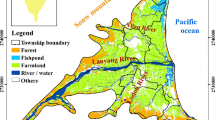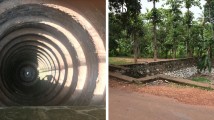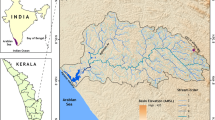Abstract
Groundwater is widely used for drinking, irrigation, and aquaculture in the Pingtung Plain, Southwestern Taiwan. The overexploitation and poor quality of groundwater in some areas of the Pingtung Plain pose great challenges for the safe use and sustainable management of groundwater resources. Thus, establishing an effective management plan for multi-purpose groundwater utilization in the Pingtung Plain is imperative. Considerations of the quality of the groundwater and potential impact on the aquifer of groundwater exploitation are paramount to multi-purpose groundwater utilization management. This study proposes a zonal management plan for the multi-purpose use of groundwater in the Pingtung Plain. The zonal management plan is developed by considering the spatial variability of the groundwater quality and the impact on the aquifer, which is defined as the ratio of the actual groundwater extraction rate to transmissivity. A geostatistical Kriging approach is used to spatially delineate the safe zones based on the water quality standards applied in the three groundwater utilization sectors. Suitable zones for the impact on the aquifer are then spatially determined. The evaluation results showing the safe water quality zones for the three types of utilization demands and suitable zones for the impact on aquifer are integrated to create a zonal management map for multi-purpose groundwater utilization which can help government administrators to establish a water resource management strategy for safe and sustainable use of groundwater to meet multi-purpose groundwater utilization requirements in the Pingtung Plain.









Similar content being viewed by others
References
Chica-Olmo, M., Luque-Espinar, J. A., Rodriguez-Galiani, V., Pardo-Igúzquiza, E., & Chica-Rivas, L. (2014). Categorical indicator Kriging for assessing the risk of groundwater nitrate pollution: the case of Vega de Granada aquifer (SE spain). Science of the Total Environment, 470–471, 229–239.
Diodato, N., & Ceccarelli, M. (2004). Multivariate indicator kriging approach using a GIS to classify soil degradation for Mediterranean agricultural lands. Ecological Indicators, 4(3), 177–187.
AERC (Agriculture Engineering Research Center) (2009). Survey, analysis and assessment of groundwater quality in Taiwan areas in 2009. Water Resources Agency, Ministry of Economic Affairs, Executive Yuan, Taiwan, pp. 100–102.
AERC (Agriculture Engineering Research Center) (2010). Survey, analysis and assessment of groundwater quality of Taiwan in 2010. Water Resources Agency, Ministry of Economic Affairs, Executive Yuan, Taiwan, pp. 151–158.
AERC (Agriculture Engineering Research Center) (2011). Survey, analysis and assessment of groundwater quality of Taiwan in 2011. Water Resources Agency, Ministry of Economic Affairs, Executive Yuan, Taiwan, pp. 191–203.
AERC (Agriculture Engineering Research Center) (2012). Survey, analysis and assessment of groundwater quality of Taiwan in 2012 – 2014 (1/3). Water Resources Agency, Ministry of Economic Affairs, Executive Yuan, Taiwan, pp. 85–101.
Chen, C. J., & Wang, C. J. (1990). Ecological correlation between arsenic level in well water and age-adjusted mortality from malignant neoplasms. Cancer Research, 50(17), 5470–5474.
Chen, C. J., Chuang, Y. C., Lin, T. M., & Wu, H. Y. (1985). Malignant neoplasma among residents of a blackfoot disease-endemic area in Taiwan: high arsenic artesian well water and cancers. Cancer Research, 45(11 Part 2), 5895–5899.
Fetter, C. W. (1994). Applied hydrogeology (3rd ed.). New York: Macmillan College Publishing Company.
Goovaerts, P. (1997). Geostatistics for natural resources evaluation (pp. 259–368). New York: Oxford University Press.
Halvorson, J. J., Smith, J. L., & Papendick, R. I. (1996). Integration of multiple soil parameters to evaluate soil quality: a field example. Biology and Fertility of Soils, 21(3), 207–214.
Hsueh, Y. M., Wu, W. L., Huang, Y. L., Chiou, H. Y., Tseng, C. H., & Chen, C. J. (1998). Low serum carotene level and increased risk of ischemic heart disease related to long-term arsenic exposure. Atherosclerosis, 141(2), 249–257.
Jang, C. S., & Liu, C. W. (2004). Geostatistical analysis and conditional simulation for estimating the spatial variability of hydraulic conductivity in the Choushui River alluvial fan, Taiwan. Hydrological Processes, 18, 1333–1350.
Jang, C. S., Chen, S. K., & Kuo, Y. M. (2012). Establishing an irrigation management plan of sustainable groundwater based on spatial variability of water quality and quantity. Journal of Hydrology, 414–415, 201–210.
Jang, C. S., Liang, C. P., & Wang, S. W. (2013). Integrating the spatial variability of water quality and quantity to probabilistically assess groundwater sustainability for use in aquaculture. Stochastic Environmental Research and Risk Assessment, 27(6), 1281–1291.
Jang, C. S., Chen, C. F., Liang, C. P., & Chen, J. S. (2016). Combining groundwater quality analysis and a numerical flow simulation for spatially establishing utilization strategies for groundwater and surface water in the Pingtung Plain. Journal of Hydrology, 533, 541–556.
Journel, A. G., & Huijbregts, C. J. (1978). Mining geostatistics. San Diego: Academic.
Lee, J. J., Liu, C. W., Jang, C. S., & Liang, C. P. (2008). Zonal management of multi-purpose use of water from arsenic-affected aquifers by using a multi-variable indicator kriging. Journal of Hydrology, 35, 260–273.
Liang, C. P., Jang, C. S., Liu, C. W., Lin, K. H., & Lin, M. C. (2010). An integrated GIS-based approach in assessing carcinogenic risks via food-chain exposure in arsenic-affected groundwater areas. Environmental Toxicology, 25, 113–123.
Liang, C. P., Liu, C. W., Jang, C. S., Wang, S. W., & Lee, J. J. (2011). Assessing and managing the health risk due to ingestion of inorganic arsenic from fish and shellfish farmed in blackfoot disease areas for general Taiwanese. Journal of Hazardous Materials, 186, 622–628.
Liang, C. P., Jang, C. S., Chen, J. S., Wang, S. W., Lee, J. J., & Liu, C. W. (2013). Probabilistic health risk assessment for ingestion of seafood farmed in arsenic contaminated groundwater in Taiwan. Environmental Geochemistry and Health, 35(4), 455–494.
Lin, Y. P., Tan, Y. C., & Rouhani, S. (2001). Identifying spatial characteristics of transmissvity using simulated annealing and kriging methods. Environmental Geology, 41, 200–208.
Molinari, A., Pedretti, D., & Fallico, C. (2015). Analysis of convergent flow tracer tests in a heterogeneous sandy box with connected gravel channels. Water Resources Research, 51, 5640–5657. doi:10.1002/2014WR016216.
Oyedele, D. J., Amusan, A. A., & Obi, A. O. (1996). The use of multiple-variable indicator kriging technique for assessment of the suitability of an acid soil for maize. Tropical Agriculture, 73(4), 259–263.
Pedretti, D., Fernàndez-Garcia, D., Bolster, D., & Sanchez-Vila, X. (2013). On the formation of breakthrough curves tailing during convergent flow tracer tests in three-dimensional heterogeneous aquifers. Water Resources Research, 49, 4157–4173. doi:10.1002/wrcr.20330.
Pedretti, D., Fernàndez-Garcia, D., Sanchez-Vila, X., Bolster, D., & Benson, D. A. (2014). Apparent directional mass-transfer capacity coefficients in three-dimensional anisotropic heterogeneous aquifers under radial convergent transport. Water Resources Research, 50, 1205–1224. doi:10.1002/2013WR014578.
Rendu, J. M. (1987). Kriging, logarithmic kriging and conditional expectation: comparison of theory with actual results. In T. J. O’Neil (Ed.), Applications of computers and operations research in mineral industry (pp. 199–212). New York: Soc. Min. Eng.
Smith, J. L., Halvorson, J. J., & Papendick, R. I. (1993). Using multiple-variable indicator kriging for evaluating soil quality. Soil Science Society of America Journal, 57, 743–749.
Taiwan CGS (Central Geological Survey) (2002) Hydrogeological survey report of pingtung plain, Taiwan (pp. 97–142). Taiwan: Central Geological Survey, Ministry of Economic Affairs, Executive Yuan.
Taiwan Sugar Company (1997) Establishment and Operational Management of Groundwater Monitoring Network. Water Resources Bureau, Taiwan, pp2–12.
Theim, G. (1906). Hydrologische (p. 56). Leipzig: Gebhardt.
Theis, C. V. (1935). The lowering of the piezometer surface and the rate and discharge of a well using groundwater storage. Transactions, American Geophysical Union, 16, 519–524.
Ting, C. S., Zhou, Y., de Vries, J. J., & Simmers, I. (1998). Development of a preliminary ground water flow model for water resources management in the Pingtung Plain, Taiwan. Ground Water, 35(6), 20–36.
Tseng, W. P. (1977). Effects and dose-response relationships of skin cancer and blackfoot disease with arsenic. Environmental Health Perspectives, 19, 109–119.
Tseng, C. H., Tai, T. Y., Chong, C. K., Tseng, C. P., Lai, M. S., Lin, B. J., et al. (2000). Long-term arsenic exposure and incidence of non-insulin-dependent diabetes mellitus: a cohort study in arseniasis-hyperendemic villages Taiwan. Environmental Health Perspectives, 108(9), 847–851.
Wu, M. M., Kuo, T. L., Hwang, Y. H., & Chen, C. J. (1989). Dose-response relation between arsenic well water and mortality from cancers and vascular diseases. American Journal of Epidemiology, 130(6), 1123–1132.
Acknowledgments
The authors would like to thank the Ministry of Science and Technology of the Republic of China for financially supporting this work under Contract No. MOST 103-2116-M-242-001.
Author information
Authors and Affiliations
Corresponding author
Electronic supplementary material
Below is the link to the electronic supplementary material.
Supplement 1
Histograms of groundwater quality items (DOC 704 kb)
Supplement 2
The experimental diagrams and fitted curves (DOC 623 kb)
Rights and permissions
About this article
Cite this article
Liang, CP., Jang, CS., Chen, CF. et al. Zonal management of multi-purposes groundwater utilization based on water quality and impact on the aquifer. Environ Monit Assess 188, 431 (2016). https://doi.org/10.1007/s10661-016-5414-0
Received:
Accepted:
Published:
DOI: https://doi.org/10.1007/s10661-016-5414-0




